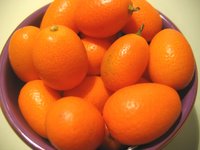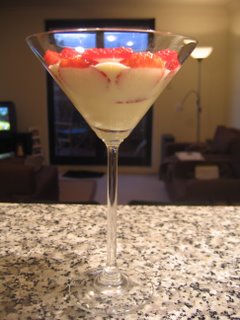 On a trip to the markets, Jonas and I came home with two very exciting finds.
On a trip to the markets, Jonas and I came home with two very exciting finds.Firstly, we bought a jar of ginger honey straight from the beekeeper from Pride of Oak. The honey was runny, liquid gold and our friendly beekeeper had steeped chunks of fresh ginger into the jar before sealing it. The flavour was divine.
 Our second treasure was Willowbrae goat's yoghurt. I first discovered Willowbrae at the Sydney Specialist Cheese Show in May this year. They are a small goat farm in the Hawkesbury who hand milk their 100 goats daily to produce some of the most delicious curds, yoghurts and soft chevre cheese.
Our second treasure was Willowbrae goat's yoghurt. I first discovered Willowbrae at the Sydney Specialist Cheese Show in May this year. They are a small goat farm in the Hawkesbury who hand milk their 100 goats daily to produce some of the most delicious curds, yoghurts and soft chevre cheese.I’m a huge fan of goat's cheese so I thought I should take the next step and try the yoghurt. It was very pungent and tasted very much like goats’ cheese. Not for the faint hearted!
Immediately upon tasting it, I thought the yoghurt would make an excellent and unique dessert.
And what perfect timing for my first entry to Jihvā For Ingredients (JFI), a monthly blogging voyage to find a gastronomic zen using a theme ingredient.
In the words of Indira from Mahanandi, who first started this event:
What is Jihvā ?
Jihvā, the Sanskrit word means taste, desire and deep longing. This powerful word also represents tongue and taste buds.
What is Jihvā for Ingredients?
I believe for Jihvā to happen, it’s all in the ingredients and how they are cooked. Jihvā for Ingredients (JFI) is online monthly food event, celebrating the ingredients and what they can do for our Jihvā.
This month the JFI host is Vineela from Vineela’s Cuisine and she has chosen “Milk and Milk Products” as her theme ingredient.
When I first started blogging I noticed there was a proliferation of food blogs in the USA, but once I started delving into English language blogs I discovered that Indians are fanatic foodies!
India’s abundant variety of fresh vegetables, fruits, herbs and spices lends itself easily to so much diverse cooking ingredients and styles. From an Australian perspective, so many Indian ingredients are rare and the recipe outcomes are utterly amazing.
I love the idea of taking part in JFI because it was originally an Indian inspired event that has become global. Now I have the opportunity to learn some of the amazing and regionally diverse cooking styles from India and all over the world!
¿What was life like before the internet?
 My contribution to my very first JFI is my own little invention inspired by my market purchases: Goat's Milk Yoghurt & Ginger Honey Fool.
My contribution to my very first JFI is my own little invention inspired by my market purchases: Goat's Milk Yoghurt & Ginger Honey Fool.This led me to wonder: where did the name “fool” come from? It’s a strange name for a dessert, but then “trifle” has similar connotations. If internet search engine results are to be believed, this dessert was called a fool because it’s light and not overly substantial. Just like the trifle.
I was nervous about my flavour combination, but it turned out to be totally delicious. The goat's milk yoghurt was tangy and the ginger honey evened it out beautifully. I recommend this highly as a light, summer dessert.
 Goat's Milk Yoghurt & Ginger Honey Fool
Goat's Milk Yoghurt & Ginger Honey FoolAnna’s very own recipe. Serves 4.
Ingredients:
250ml (1 cup) goat's milk yoghurt
190ml (¾ cup) thickened cream
60g (¼ cup) superfine caster sugar
2 tablespoons ginger honey*
Fruit to serve
Method:
1. Over a medium heat, stir sugar and cream in a saucepan until the sugar is dissolved.
2. Cool to room temperature.
3. Add the yoghurt and honey then whisk until smooth.
4. Pour into a bowl, cover with plastic wrap and chill until cold.
5. Serve with fruit such as strawberries, mangoes, plums, peaches or even passionfruit pulp. (In my photo I garnished it with slices of candied cumquats.)
Note: *Ginger honey is simply honey that has had pieces of fresh ginger infused in it.
I encourage everyone to visit Vineela’s recap to discover some of the wonderful milk based recipes out there in the blogosphere!






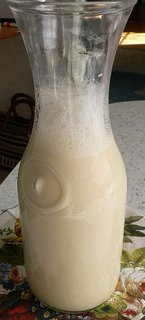


 Calamares Rellenos
Calamares Rellenos Parsley (Petroselinum - Umbelliferae) is a biennial herb that comes in two main forms: curly and flat varieties (flat leaf is also known as continental or Italian parsley). The curly variety is used as a garnish and is bitter, while the flat leaf is known to have a stronger flavour due to increased levels of essential oil (apiol).
Parsley (Petroselinum - Umbelliferae) is a biennial herb that comes in two main forms: curly and flat varieties (flat leaf is also known as continental or Italian parsley). The curly variety is used as a garnish and is bitter, while the flat leaf is known to have a stronger flavour due to increased levels of essential oil (apiol).







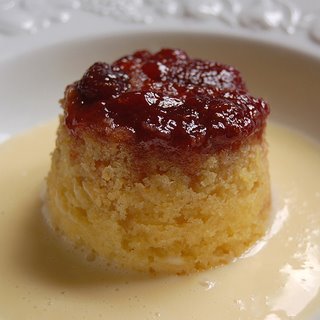


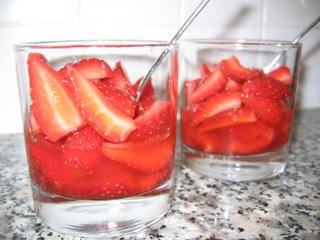

 The strawberry (Fragaria) is the fruit from a genus of plants in the family Rosaceae, which includes roses.
The strawberry (Fragaria) is the fruit from a genus of plants in the family Rosaceae, which includes roses. 





 With our tea came the three level tower of treats:
With our tea came the three level tower of treats:
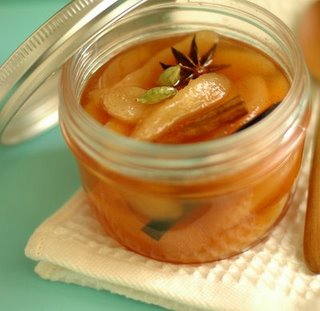



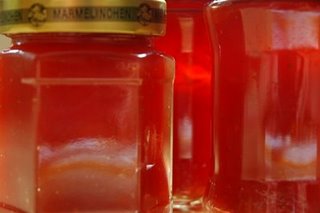
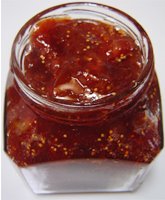





 Flash forward a few days and I have since had time to come to the realisation that I’m not special and that I wasn’t the first person, nor obviously the last, to make some sort of gooey sweetness out of cute little cumquats.
Flash forward a few days and I have since had time to come to the realisation that I’m not special and that I wasn’t the first person, nor obviously the last, to make some sort of gooey sweetness out of cute little cumquats.